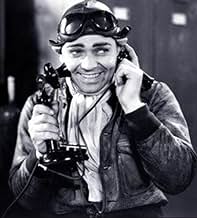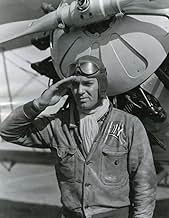Rival fighter-pilots train in the art of dive bombing while teasing each other about their bravery and manliness. They wind up stranded and must work together for a common goal.Rival fighter-pilots train in the art of dive bombing while teasing each other about their bravery and manliness. They wind up stranded and must work together for a common goal.Rival fighter-pilots train in the art of dive bombing while teasing each other about their bravery and manliness. They wind up stranded and must work together for a common goal.
- Awards
- 3 wins total
Virginia Bruce
- Girl
- (scenes deleted)
John Kelly
- Sailor
- (scenes deleted)
Eric Alden
- Sailor
- (uncredited)
John George
- Barfly
- (uncredited)
Sherry Hall
- Naval Officer
- (uncredited)
Pat O'Malley
- Commander of the 'Los Angeles'
- (uncredited)
Featured reviews
Wallace Beery hams it up mercilessly as a 'loveable slob' of a Navy Chief Petty Officer on the USS Saratoga. His lofty position is soon challenged by a hard-nosed and far more competent young chief played by Clark Gable. Beery, rather than bring his own standard up, seeks to sabotage Gable, leading to several confrontations where Beery is ultimately outclassed. The film concludes with a sentimental but well-played ending.
The movie has many charms to offset its drawbacks. There is a lot of footage of the USS Saratoga, the Navy's first big carrier, built on the hull of a cancelled battlecruiser. The Saratoga footage alone, along with that of other circa-1932 warships, makes this a must-see for naval buffs. This is also an early starring role for Gable, who plays his part well and looks every inch the young, dashing, competent CPO. Beery himself exudes charm despite overplaying his part. Look also for the ex-Mack Sennett bathing beauty Marie Prevost as the worldly Lulu.
Despite its uneven mix of comedy and drama, not to mention a boatload of Navy cliches, this movie is well worth watching, especially for Navy buffs.
The movie has many charms to offset its drawbacks. There is a lot of footage of the USS Saratoga, the Navy's first big carrier, built on the hull of a cancelled battlecruiser. The Saratoga footage alone, along with that of other circa-1932 warships, makes this a must-see for naval buffs. This is also an early starring role for Gable, who plays his part well and looks every inch the young, dashing, competent CPO. Beery himself exudes charm despite overplaying his part. Look also for the ex-Mack Sennett bathing beauty Marie Prevost as the worldly Lulu.
Despite its uneven mix of comedy and drama, not to mention a boatload of Navy cliches, this movie is well worth watching, especially for Navy buffs.
Clark Gable's on-screen persona was becoming more popular in his second year in Hollywood with each movie he appeared. He reached new heights by sharing top billing with MGM's highest paid actor, Wallace Beery, in January 1932's "Hell Divers." In this United States Naval aviation action film, Beery and Gable play rivals as aerial gunners in the Navy's Squadron One Battle Force. The flying squadron, stationed on one of the newer aircraft carriers at the time, the USS Saratoga, was made up of Curtiss F8C-4 bombers, nicknamed "Helldivers." The Navy fully cooperated with MGM, giving cinematographer Charles Marshall as much access he needed to film the aviators flying the Helldivers throughout the San Diego North Island Naval Air Station vacinity.
"Hell Divers" was the second film between Beery and Gable, who later admitted he hated working with the seasoned actor. The film's similar storyline to "What Price Glory?" shows the pair's characters first at odds with one another, then bonding in the concluding scenes. Gable experienced two enduring qualities that he came to appreciate from the film: the larger part further elevated his visibility with the public, and his drinking habits changed by introducing him to gin with a wedge of lemon, a favorite beverage for the Navy men whom he associated with while making the film. After seeing the fliers sucking a slice of lemon between gulps, he adopted this method for the remainder of his life.
"Hell Divers" was George Hill's second to last film he directed before an auto accident in 1934 cut his life short. He had a string of hits throughout his career, becoming more successful when talkies arrived, including 1930's "The Big House" and 1931's "Min and Bill." His marriage to screenwriter Frances Marion in 1930 ended in divorce three years later. Hill directed one more film after "Hell Divers" in 1933 before he was assigned to Pearl Buck's book adaptation in "The Good Earth." Severe injuries he sustained from a 1934 car crash made him so despondent that he was found with self-inflicted gunshot wounds inside his Venice, California, beach house in August 1934. He was 39 years old.
"Hell Divers" was the second film between Beery and Gable, who later admitted he hated working with the seasoned actor. The film's similar storyline to "What Price Glory?" shows the pair's characters first at odds with one another, then bonding in the concluding scenes. Gable experienced two enduring qualities that he came to appreciate from the film: the larger part further elevated his visibility with the public, and his drinking habits changed by introducing him to gin with a wedge of lemon, a favorite beverage for the Navy men whom he associated with while making the film. After seeing the fliers sucking a slice of lemon between gulps, he adopted this method for the remainder of his life.
"Hell Divers" was George Hill's second to last film he directed before an auto accident in 1934 cut his life short. He had a string of hits throughout his career, becoming more successful when talkies arrived, including 1930's "The Big House" and 1931's "Min and Bill." His marriage to screenwriter Frances Marion in 1930 ended in divorce three years later. Hill directed one more film after "Hell Divers" in 1933 before he was assigned to Pearl Buck's book adaptation in "The Good Earth." Severe injuries he sustained from a 1934 car crash made him so despondent that he was found with self-inflicted gunshot wounds inside his Venice, California, beach house in August 1934. He was 39 years old.
Okay, I know that most Wallace Beery films are pretty formulaic and superficial. However, this doesn't mean they were bad. Very few of his films were bad, though many fall in the average category. However, occasionally, his films rose above the mundane, such as DINNER AT EIGHT, GRAND HOTEL, MIN AND BILL and this film. While I will admit this movie isn't up to the standards of the three films I listed, it does approach them in quality and is a decent effort for him and new-comer Clark Gable. In particular, if you are a Gable or airplane buff, like me, you will love this film. It features a lot of great flying sequences you just won't see in many films of the era. Our aircraft carriers and dirigibles just weren't seen as being very important and weren't shown in many films during the Depression era. So, from a purely historic point of view, this is an important film. When you add good acting and dialog and an exciting script, you have an excellent film well worth your time.
Any time you have two fantastic actors of the calibres of Wallace Beery and Clark Gable playing against each other, it's worth a look. Beery was the highest paid actor in the world when this movie was shot, and he was certainly the most interesting to watch. It's obvious, though, that MGM was using this picture to build up their popular new romantic lead, Gable, even if it had to be at their top star's expense. If you like this one, I recommend a better seafaring film with Beery and Gable, 1935's "China Seas." That one's a real spectacular, one of those movies, like "Dancing Lady," with everything the studio could think of thrown in.
1930's US Navy film with, oh boy, 2 great actors Wallace Berry and Clark Gable! I loved it from the shore leave aspects and the super vintage era aircraft (Derigibles too!) and ships that you'll hardly ever see because it was'nt during a "major" war. Highly recommended, I loved it ( but I am a big fan of the mentioned stars and a sailor so I'm definetly biased, LOL)!
Did you know
- TriviaFlight operations were filmed aboard the USS Saratoga. Scenes of planes landing on the carrier deck were edited post-production to obscure the actual operation of the aircraft arresting gear.
- GoofsThe under-wing bombs appear and disappear in many shots. Often a plane will be shown taxiing with bombs under the wing, then taking off and flying with no bombs. When the bombing runs begin, the bombs are again visible.
- Quotes
CPO Steve Nelson: And if you want to know what this is, it's a bomb! And there's enough T.N.T. in it to blow us to Smithereens.
Ann Mitchell: I've always wanted to go to Smithereens.
- ConnectionsEdited into L'aigle vole au soleil (1957)
- SoundtracksAnchors Aweigh
(1906) (uncredited)
Written by Charles A. Zimmerman
Lyrics by Alfred Hart Miles and R. Lovell
Played during the opening credits
Details
- Release date
- Country of origin
- Language
- Also known as
- Les Plongeurs de l'Enfer
- Filming locations
- USS Saratoga CV-3(Flight deck operations)
- Production company
- See more company credits at IMDbPro
- Runtime
- 1h 49m(109 min)
- Color
Contribute to this page
Suggest an edit or add missing content

























